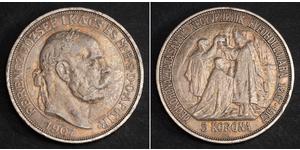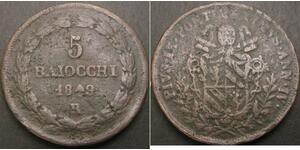2 Stiver (sold for $44.0)
1724, Netherlands, Holland. Silver 2 Stuivers Coin. Ex Akerendam Shipwreck Set!
Mint Year: 1724
Province: Holland
Reference: KM-48.
Denomination: 2 Stuivers (Double Wapenstuiver)
Condition: Environmental damage (corrosion/deposits), typical for the Akerendam shipwreck coins, otherwise XF!
Material: Silver (.583)
Diameter: 19mm
Weight: 1.57gm
Obverse: Crowned shield with arms of Holland, splitting value (2-S) in fields.
Reverse: Rosette above province name, date and mint mark.
Legend: .*. / HOL / LAN / DIA . / 1724
Akerendam was a ship of the Dutch East India Company (VOC), built in 1724. On 19 January 1725, Akerendam left in convoy with two other ships, heading for Batavia with a crew of 200 people and 19 chests of gold and silver on board. On 8 March 1725 Akerendam drifted in a snow storm and sank near the cliffs of Runde island (Norwegian west coast). Despite the fact that the ship was wrecked close to the shore there were no survivors.
During the next months, five chests of coins were recovered. No more was found and the site was forgotten until Swedish and Norwegian sports divers rediscovered the wreck site in 1972. Although little remained of the ship, about 57,000 gold and silver coins were recovered. The 6,600 gold coins were mostly the rare Dutch gold ducats, minted in Utrecht in 1724; prior to this find only a handful of these ducats were known. Norway's largest coin treasure is also referred to as "the Runde Treasure".
The Norwegian share of the Runde treasure was divided between the Museum of Cultural History's Coin Cabinet and Bergen Maritime Museum. In January 2011, some of the coins from the Maritime Museum were transported back to the island for an exhibition at Runde Miljøsenter. The divers' portion of 75% of the treasure was auctioned in Switzerland in 1978.
The Republic of the Seven United Netherlands (or "of the Seven United Provinces") (Republiek der Zeven Verenigde Nederlanden/Provinciën; also Dutch Republic or United Provinces in short, Foederatae Belgii Provinciae or Belgica Foederata in Latin) was a European republic between 1581 and 1795, in about the same location as the modern Kingdom of the Netherlands, which is the successor state.
Before 1581, the area of the Low Countries consisted of a number of duchies, counties, and independent bishoprics, some but not all of them part of the Holy Roman Empire. Today that area is divided between the Netherlands, Belgium, Luxembourg and parts of France and Germany. The Low Countries in the 16th century roughly corresponded to the Seventeen Provinces covered by the Pragmatic Sanction of 1549 of Holy Roman Emperor Charles V.
Through marriage, war or sale, these states were acquired by the Habsburg emperor Charles V and his son, king Philip II of Spain. In 1568, the Netherlands, led by William I of Orange, revolted against Philip II because of high taxes, persecution of Protestants by the government, and Philip's efforts to modernize and centralize the devolved medieval government structures of the provinces. This was the start of the Eighty Years' War.
In 1579, a number of the northern provinces of the Netherlands signed the Union of Utrecht, in which they promised to support each other in their defence against the Spanish army. This was followed in 1581 by the Act of Abjuration, the declaration of independence in which the provinces officially deposed Philip II.
The United Provinces first tried to choose their own lord, and they asked the Duke of Anjou (sovereign from 1581-1583) to rule them. Later, after the assassination of William of Orange (July 10, 1584), both Henry III of France and Elizabeth I of England declined the offer of sovereignty. However, the latter agreed to turn the United Provinces into a protectorate of England (Treaty of Nonsuch, 1585), and sent the Earl of Leicester as governor-general. This was not a success, and in 1588 the provinces became a Republic.

|
Posted by:
anonymous 2024-08-15 |
|
||
|
||
|
||
|
||
5 Korona Austria-Hungary (1867-1918) Silver Franz Joseph I ( ...
group has 18 coins / 16 prices
⇑
5 Baiocco Papal States (752-1870) Copper
group has 5 coins / 5 prices
⇑

-600-300-SdCsHgTyOWQAAAGRNeaMclfS.jpg)

-300-150-83fBwcI0kzYAAAEqRKZDRaTM.jpg)
 Deutsch
Deutsch Русский
Русский Українська
Українська English
English Italiano
Italiano Français
Français Español
Español 汉语
汉语




-300-150-ZDsKbzbiSMsAAAFRYnVauzdX.jpg)

-300-150-0NUKqUpYMOAAAAFhLv2s79Xd.jpg)






